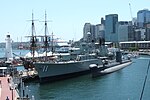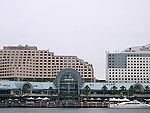Pyrmont Bridge

The Pyrmont Bridge, a heritage-listed swing bridge across Cockle Bay, is located in Darling Harbour, part of Port Jackson, west of the central business district in the City of Sydney local government area of New South Wales, Australia. Opened in 1902, the bridge initially carried motor vehicle traffic via the Pyrmont Bridge Road between the central business district and Pyrmont. Since 1981 the bridge has carried pedestrian and bicycle traffic only, as motor vehicles were diverted to adjacent freeway overpasses. The bridge was added to the New South Wales State Heritage Register on 28 June 2002, the centenary of its opening.The Jimmy Barnes' 1985 song "I'd die to be with you Tonight" was filmed on the Bridge, with it in the swing-out configuration. (See:I'd_Die_to_Be_with_You_Tonight)
Excerpt from the Wikipedia article Pyrmont Bridge (License: CC BY-SA 3.0, Authors, Images).Pyrmont Bridge
Pyrmont Bridge, Sydney Sydney
Geographical coordinates (GPS) Address External links Nearby Places Show on map
Geographical coordinates (GPS)
| Latitude | Longitude |
|---|---|
| N -33.870575 ° | E 151.200667 ° |
Address
Pyrmont Bridge
Pyrmont Bridge
2000 Sydney, Sydney
New South Wales, Australia
Open on Google Maps









